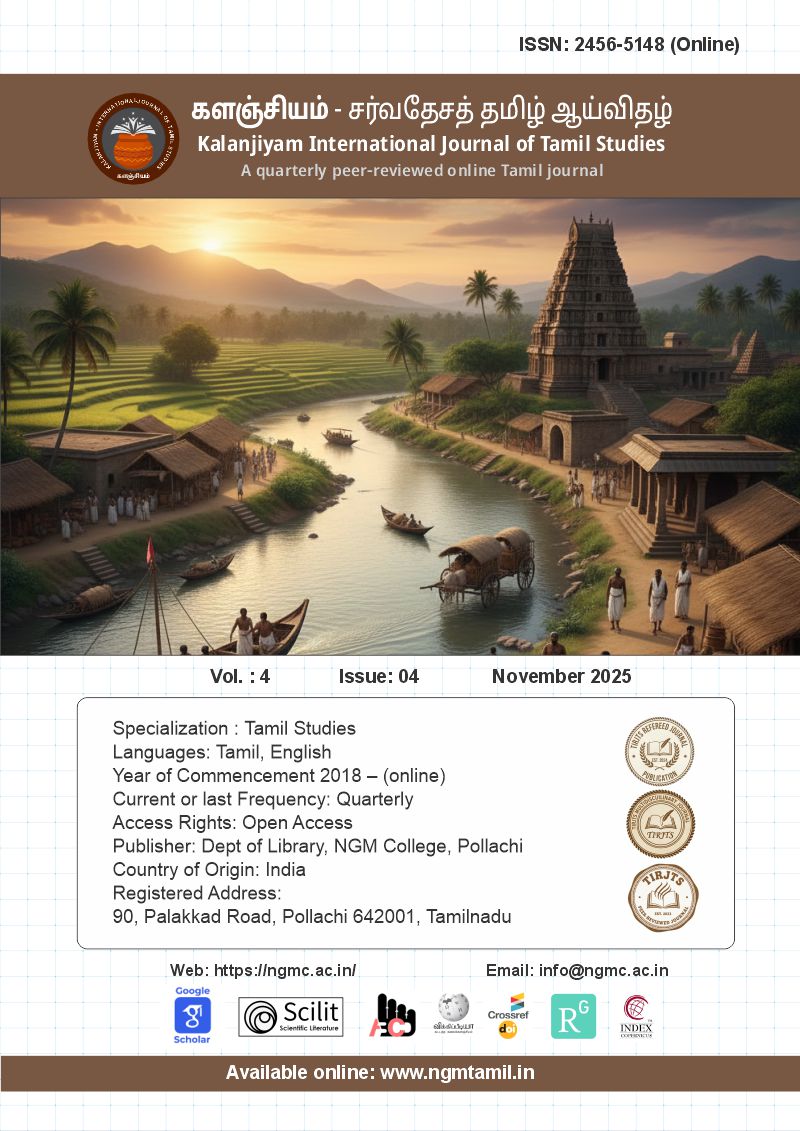சங்க இலக்கியங்கள் வழி அறியலாகும் பண்டைய கால மக்களின் தொழில்கள்
THE PROFESSIONS OF ANCIENT PEOPLE AS REVEALED THROUGH SANGAM LITERATURE
DOI:
https://doi.org/10.63300/kirjts0404202503Keywords:
Agricultural industries, Commercial industries, Fishing-Pearl miningAbstract
The criterion for determining the civilizational development of a country is its professional development. In this regard, the ancient Tamils were efficient in all activities, from choosing a profession to successfully taking it to a stage of development. Not only that, they were also excellent in improving their economic status through these professions. This article aims to examine and explain how ancient people organized their professions. This organization was not merely a list of jobs, but a complex, sustainable socioeconomic architecture. Their efficiency stemmed from a clear division of labor, ensuring deep specialization that fostered powerful internal trade and robust maritime links. We will delve into the rich tapestry of Sangam literature and archaeological evidence to map the intricate occupational divisions, revealing how professional roles—from farming and metallurgy to seafaring and fine arts—were not only respected but intricately woven into the very fabric of their societal hierarchy, guaranteeing both economic stability and cultural continuity for millennia.
ஒரு நாட்டின் நாகரிக வளர்ச்சியினைத் தீர்மானிக்கும் அளவுகோலாய் அமைவது அந்நாட்டின் தொழில்முறை வளர்ச்சியே ஆகும். அந்த வகையில், ஒரு தொழிலைத் தேர்ந்தெடுப்பது முதல் அதனை வளர்ச்சி நிலைக்கு வெற்றிகரமாகக் கொண்டு செல்வது வரை எல்லாச் செயல்களிலும் பழந்தமிழர்கள் திறமையுடன் செயல்பட்டனர். அதுமட்டுமின்றி, இத்தொழில்கள் மூலம் தங்களுடைய பொருளாதாரத் தரத்தை மேம்படுத்திக் கொள்வதிலும் சிறந்து விளங்கினர். பண்டைய கால மக்கள் எவ்வாறு தங்கள் தொழில்களை அமைத்துக்கொண்டனர் என்பதை ஆராயந்து விளக்குவதாக இக்கட்டுரை அமைந்துள்ளது.
Downloads
References
1. Arimathi Ilambarathi. Sangam Ilakkiyathil Melāṇmai. Ilakshmi Nilayam, 2006.
2. Ā.Ku. Vaṇika Poruliyal. Raja Publications, 2010.
3. Ā.Ku. Samūgaviyal Koḷkaikaḷ. Anna University, Paari Nilayam, 2000.
4. Sivalinganaar, A. Tholkāppiyam. Ulaththamizharāyarchi Niṟuvanam, 2021.
5. Parimelazhagar. Thirukkural. Thirumagal Nilayam, July 2014.
6. Balasubramanian, Ku. Ve. Kurunthokai (Mūlamum Uraiyum). New Century Book House (P) Ltd, April 2004.
7. Balasubramanian, Ku. Ve. Akanāṉūṟu (Mūlamum Uraiyum). New Century Book House (P) Ltd, April 2004.
8. Balasubramanian, Ku. Ve. Puṟanāṉūṟu (Mūlamum Uraiyum). New Century Book House (P) Ltd, April 2004.
9. Balasubramanian, Ku. Ve. Kaliththokai (Mūlamum Uraiyum). New Century Book House (P) Ltd, April 2004.
Downloads
Published
Issue
Section
License
Copyright (c) 2025 Dr.P.KARPAGARAMAN (Author)

This work is licensed under a Creative Commons Attribution 4.0 International License.
Our journal adopts CC BY License Creative Commons Attribution 4.0 International License http://Creativecommons.org//license/by/4.0/ . It allows using, reusing, distributing and reproducing of the original work with proper citation.






